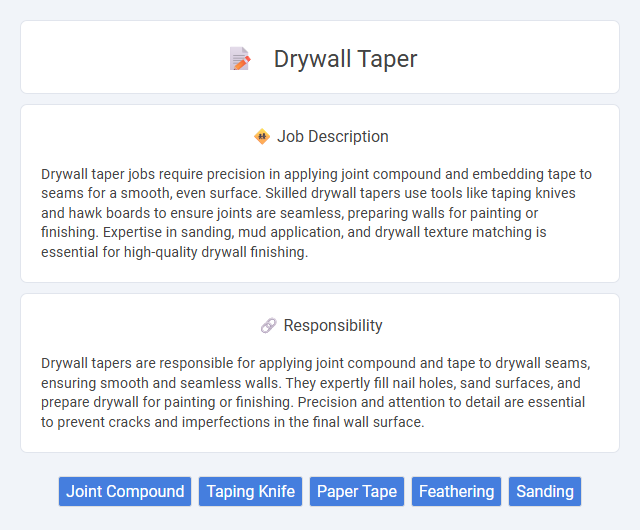
Drywall taper jobs require precision in applying joint compound and embedding tape to seams for a smooth, even surface. Skilled drywall tapers use tools like taping knives and hawk boards to ensure joints are seamless, preparing walls for painting or finishing. Expertise in sanding, mud application, and drywall texture matching is essential for high-quality drywall finishing.
Individuals with good manual dexterity, attention to detail, and the ability to work in physically demanding environments are likely to be suitable for drywall taper jobs. Those who can maintain focus for extended periods and have a steady hand may have a higher probability of succeeding in this role. People with respiratory issues or sensitivities to dust and chemicals might find this job challenging due to the nature of the materials and work environment.
Qualification
Successful drywall taper jobs require precise skill in applying joint compound and tape to drywall seams, ensuring smooth and durable finishes. Qualified drywall tapers typically possess experience in drywall installation techniques, proficiency with finishing tools, and a keen eye for detail to prevent cracks and imperfections. Certification or training programs in drywall finishing significantly enhance a taper's qualifications, boosting the quality and consistency of the drywall surfaces.
Responsibility
Drywall tapers are responsible for applying joint compound and tape to drywall seams, ensuring smooth and seamless walls. They expertly fill nail holes, sand surfaces, and prepare drywall for painting or finishing. Precision and attention to detail are essential to prevent cracks and imperfections in the final wall surface.
Benefit
A drywall taper job likely enhances wall smoothness by seamlessly applying joint compound and tape, reducing visible seams and imperfections. It probably improves overall wall durability and appearance, making the surface more prepared for painting or finishing. Hiring a skilled taper may save time and prevent costly repairs by ensuring proper joint treatment from the start.
Challenge
Drywall taper jobs likely present challenges related to achieving smooth, even seams in tight or awkward spaces. Inconsistent application of joint compound can result in visible imperfections, increasing the probability of rework. Mastery of precise tool control and timing may significantly reduce these difficulties.
Career Advancement
A drywall taper job offers significant opportunities for career advancement through skill development in taping, mudding, and finishing techniques essential for creating smooth wall surfaces. Mastery in drywall tapering can lead to higher-paying roles such as lead taper, drywall supervisor, or estimator, with increased responsibility on large-scale construction projects. Continuous learning and certification in advanced drywall systems enhance employability and open doors to specialized positions within the construction and remodeling industry.
Key Terms
Joint Compound
A drywall taper expertly applies joint compound to seams, ensuring a smooth and even surface that hides joints and fasteners in drywall installations. Using high-quality joint compound enhances adhesion, reduces sanding time, and prevents cracking or shrinking for a flawless finish. Properly mixing, applying, and drying the joint compound is critical to achieving professional-grade drywall finishes that prepare walls for painting or wallpapering.
Taping Knife
A drywall taper relies heavily on a high-quality taping knife to achieve smooth, seamless joints in drywall installation. The taping knife's flexible stainless-steel blade allows precise application of joint compound, essential for blending drywall tape and filling gaps. Professional drywall finishers prefer knives ranging from 6 to 12 inches wide to ensure efficient coverage and a flawless surface ready for sanding and painting.
Paper Tape
A drywall taper specializes in applying paper tape to seam joints, ensuring a smooth, crack-resistant finish essential for professional drywall installations. Paper tape, made from durable paper fiber, adheres to joint compounds and provides superior bonding strength compared to mesh alternatives. Proper technique in embedding and finishing paper tape prevents visible seams and enhances the overall durability and aesthetic of interior walls.
Feathering
Drywall tapers specialize in applying joint compound to seams and corners, ensuring a smooth finish through the technique of feathering, which gradually thins the compound edges for seamless blending with adjacent surfaces. Mastery of feathering requires precision and patience to avoid visible ridges and achieve a flawless wall or ceiling appearance. Proper feathering enhances the durability and aesthetic quality of drywall installations, making it a critical skill in drywall finishing.
Sanding
Sanding is a critical step in a drywall taper job that ensures a smooth, even surface before painting or finishing. Proper sanding removes imperfections such as ridges, bumps, and excess joint compound, enhancing the wall's overall appearance and durability. Using fine-grit sandpaper and sanding poles helps achieve a flawless finish, reducing the need for additional touch-ups.
 kuljobs.com
kuljobs.com